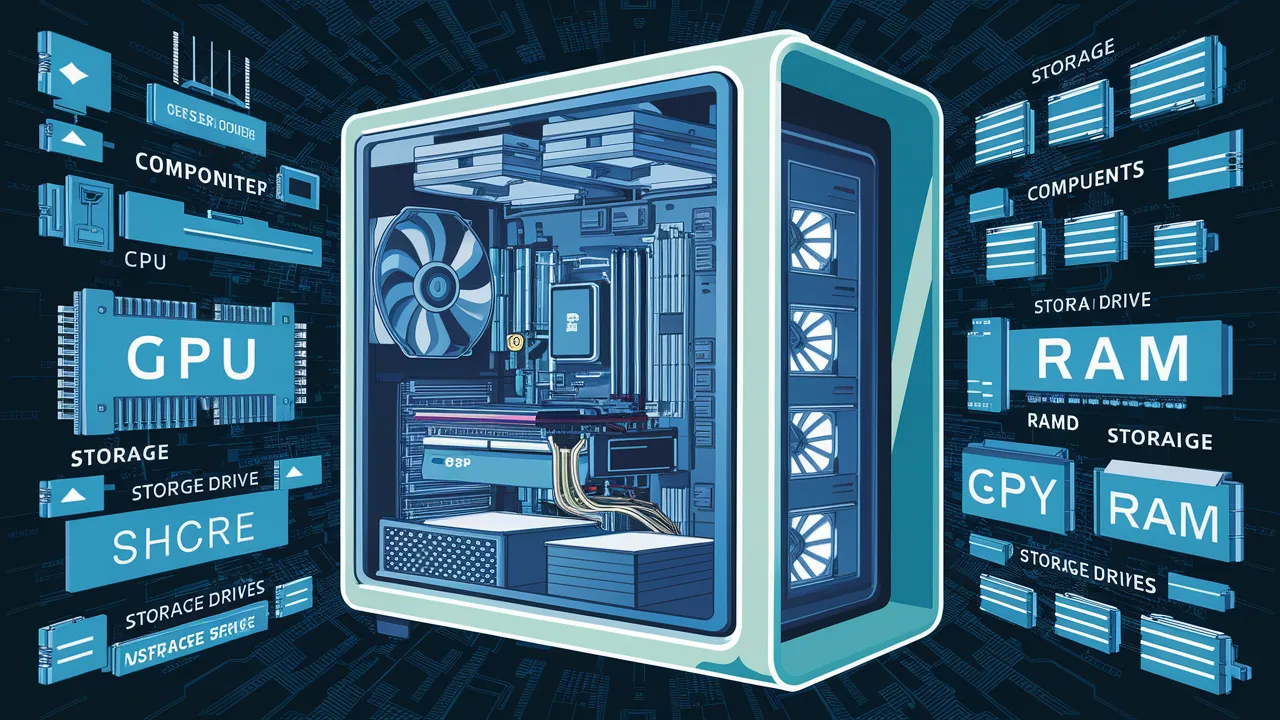
Introduction
In the vast world of computers, hardware is the physical foundation that makes everything possible. Whether you’re a casual user or a tech enthusiast, understanding the key components of computer hardware is essential. This guide will break down the major parts of a computer, explaining their functions and how they work together to make your machine run smoothly.
What is Computer Hardware?
Computer hardware refers to the physical parts of a computer system that you can touch and see. These components include everything from the motherboard to the power supply, each playing a critical role in the computer’s operation.
Definition and Importance
- Definition: Computer hardware encompasses all the physical elements of a computer, such as the central processing unit (CPU), memory (RAM), storage devices, and peripheral devices like keyboards and mice.
- Importance: Without hardware, there would be no platform for software to run on. Hardware and software work hand-in-hand to perform computing tasks.
Central Processing Unit (CPU)
The CPU, often referred to as the brain of the computer, is crucial for executing instructions and processing data.
Function and Types
- Function: The CPU performs calculations, runs programs, and processes data. It handles tasks by fetching instructions from memory, decoding them, and executing them.
- Types: CPUs come in various forms, including single-core, dual-core, quad-core, and multi-core processors. Multi-core processors can handle multiple tasks simultaneously, enhancing performance.
Random Access Memory (RAM)
RAM is the computer’s short-term memory, used for temporarily storing data that the CPU needs quick access to.
Role and Capacity
- Role: RAM allows your computer to perform multiple tasks at once without slowing down. When you open an application, it loads from the storage drive into the RAM for faster access.
- Capacity: The amount of RAM affects the computer’s performance. More RAM means the ability to run more applications simultaneously and handle larger workloads.
Storage Devices
Storage devices hold all your data, from the operating system to personal files.
Types of Storage
- Hard Disk Drives (HDDs): Traditional storage devices that use spinning disks to read and write data. They offer large storage capacities at a lower cost but are slower than SSDs.
- Solid State Drives (SSDs): Faster and more reliable than HDDs, SSDs use flash memory to store data. They provide quicker boot times and faster data access but are more expensive per gigabyte.
- Hybrid Drives: Combine HDD and SSD technologies to offer a balance of speed and storage capacity.
Motherboard
The motherboard is the main circuit board that connects all the components of a computer.
Function and Components
- Function: It houses the CPU, RAM, and other essential components. It provides connectors for other peripherals and expansion cards.
- Components: Includes slots for RAM, CPU socket, power connectors, SATA connectors for storage devices, and PCIe slots for graphics cards and other expansion cards.
Power Supply Unit (PSU)
The PSU provides power to all components of the computer.
Role and Specifications
- Role: Converts electricity from your wall outlet into a usable form for the computer. It ensures that each component receives the appropriate voltage and current.
- Specifications: PSUs are rated by wattage. The power needs depend on the components of your computer. Higher-end systems with powerful GPUs and multiple drives require more power.
Graphics Processing Unit (GPU)
The GPU is responsible for rendering images, videos, and animations.
Integrated vs. Dedicated
- Integrated Graphics: Built into the CPU, suitable for basic tasks like web browsing and office applications.
- Dedicated Graphics: Separate cards with their own memory and processing power, ideal for gaming, video editing, and other graphics-intensive tasks.
Cooling Systems
Proper cooling is essential to prevent overheating and ensure stable performance.
Types of Cooling
- Air Cooling: Uses fans and heat sinks to dissipate heat. Common in most desktop and laptop computers.
- Liquid Cooling: More efficient than air cooling, using a liquid coolant to transfer heat away from components. Often used in high-performance and gaming PCs.
Input and Output Devices
These peripherals allow users to interact with the computer and receive information.
Common Devices
- Input Devices: Keyboards, mice, scanners, and webcams allow users to input data into the computer.
- Output Devices: Monitors, printers, and speakers present data to the user in various forms.
Expansion Cards
Expansion cards enhance the capabilities of a computer.
Types of Expansion Cards
- Sound Cards: Improve audio quality and provide advanced audio features.
- Network Cards: Enable wired or wireless network connectivity.
- USB Expansion Cards: Provide additional USB ports for connecting peripherals.
BIOS/UEFI
The BIOS (Basic Input/Output System) or UEFI (Unified Extensible Firmware Interface) initializes hardware during the boot process.
Functions
- System Initialization: Checks hardware components and loads the operating system.
- Configuration: Allows users to configure hardware settings and manage system resources.
Connecting Peripherals
Understanding how to connect and use various peripherals is essential for maximizing your computer’s functionality.
Common Connections
- USB Ports: Widely used for connecting keyboards, mice, storage devices, and other peripherals.
- HDMI/DisplayPort: Connects monitors and projectors for video output.
- Audio Jacks: Connect speakers, headphones, and microphones.
Maintenance and Upgrades
Regular maintenance and timely upgrades can extend the lifespan and improve the performance of your computer.
Tips for Maintenance
- Cleaning: Regularly clean dust from components to prevent overheating.
- Updates: Keep your operating system and drivers up to date.
- Backup: Regularly back up important data to avoid loss.
Upgrading Components
- RAM: Adding more RAM can boost performance.
- Storage: Upgrading to an SSD can significantly speed up your system.
- GPU: A new GPU can enhance gaming and graphic-intensive tasks.
Conclusion
Understanding computer hardware is the first step toward mastering technology. Each component plays a crucial role in the overall functionality of the computer, and knowing how they work together can help you troubleshoot issues, perform upgrades, and maintain your system effectively. Dive deeper into each component, explore resources, and don’t be afraid to get hands-on to further enhance your knowledge.
FAQs
What is the most important hardware component in a computer?
The CPU is often considered the most important as it performs all the calculations and tasks. However, every component is essential for the overall performance of the computer.
How much RAM do I need for my computer?
It depends on your usage. For basic tasks, 8GB is usually sufficient. For gaming, video editing, or running multiple applications simultaneously, 16GB or more is recommended.
Can I upgrade my laptop’s hardware?
Some laptops allow for RAM and storage upgrades. However, components like the CPU and GPU are typically soldered onto the motherboard and cannot be upgraded.
What should I look for when buying a new computer?
Consider your needs: processing power (CPU), memory (RAM), storage type and capacity (SSD vs. HDD), and graphics capabilities (integrated vs. dedicated GPU).
How often should I clean my computer?
Regular cleaning, at least every six months, helps prevent dust buildup, which can cause overheating and reduce the lifespan of components.


